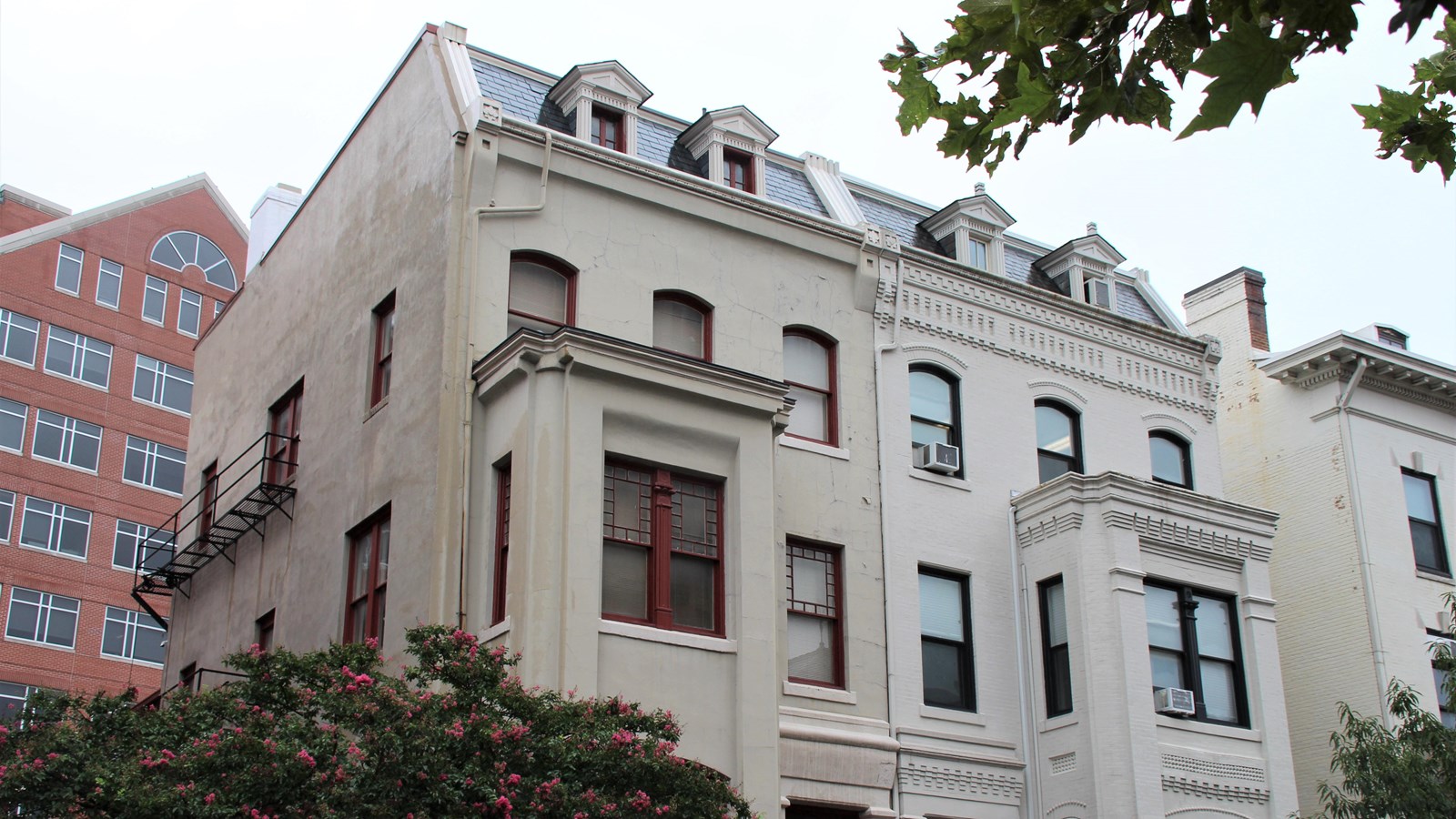Last updated: September 26, 2024
Place
Elliott Coues House

Kathryn Smith, NPS, National Capital Area, September 10, 2020
Nestled in the Washington, D.C. neighborhood of Dupont Circle, the Coues House was the residence of prominent American ornithologist Elliott L. Coues from 1887 to his death in 1899. Coues revolutionized the scientific study of American birds and helped found the American Ornithologists Union in 1883, an active organization that promotes the study and conservation of North America’s diverse bird life. During his time at the Dupont Circle house, Coues studied and wrote about several little-known bird species of the American Southwest and Rocky Mountain regions, one of which now bears his name: the Cactus Wren (Campylorhynchus couesi).
Elliott Ladd Coues was born in Portsmouth, New Hampshire in 1842. When he was eleven, the Coues family moved to Washington, D.C., after Elliott’s father secured a job as a U.S. Patent officer. Coues’s interest in biology and ornithology began at an early age. At age 17, Coues journeyed through New England where he “ransack[ed] the woods” of his native New Hampshire looking for unique birds and other local fauna. Shortly thereafter, Coues was invited by ornithologist Dr. Thomas Brewer to explore the wild coast of Newfoundland and Labrador and document the region’s diverse shorebird populations. After returning from Canada in 1863, Coues pursued a medical degree at the Columbian College, now known as George Washington University. During his studies, Coues frequented Washington’s surrounding marshland and other natural areas in search of local bird species.
After acquiring his medical degree in 1863, Coues joined the United States military and was commissioned an assistant surgeon during the final phases of the Civil War. His first assignment was on an expedition to the Pacific Coast of California. While the purpose of the expedition was to reinforce several U.S. forts in the Southwest, Coues used the opportunity to advance his passion for ornithology. Coues began the arduous journey westward from St. Louis, Missouri to Southern California in April of 1864. This experience was formative for Coues’ scientific career as it exposed him to the diverse and little-recorded wildlife of the American West leading him to publish several ornithological books and encyclopedias. Coues’ trek through the Colorado Valley in 1864 prompted his identification of several bird species then unknown to science including the White Throated Swift and the Southwestern House Finch.
In 1865 Coues’ Army unit was posted to Fort Whipple in the Arizona Territory, a loosely defined western region that was sparsely populated by American settlers. Initially, Coues’ research endeavors were hampered by the lack of scientific supplies at the remote outpost and the continuous conflict between U.S. forces and American Indian groups, particularly the Apache. Nonetheless, Coues was able to advance his ornithological career at Fort Whipple, and in 1872 he published the first edition of his mammoth ornithological survey Key to North American Birds. From 1873 to 1876, Coues served as the Northern Boundary Commission’s naturalist and secretary, a position that allowed him to further advance the nation’s scientific knowledge of the flora and fauna of the Upper Rockies and Great Plains. Coues returned to Washington, D.C., in 1877 where he began lecturing at Columbian College. In 1883 he cofounded the American Ornithologists Union which, to this day, continues to present researchers with the Elliott Coues Award for distinguished biological scholarship.
In 1887, Coues purchased a three-story brick townhouse on N Street near Dupont Circle where he lived with his family until his death in 1899. From this simple, semi-detached rowhome, Coues pursued his passion for the history of the American West and edited dozens of memoirs, articles, and research papers on the topic. In 1893, Coues wrote a several volume chronicle of the Lewis and Clark Expedition that some historians have credited with reviving popular interest in the topic. In the last decade of his life, Coues became involved in the Theosophical Movement, a spiritual movement aimed at using scientific principles to explain the afterlife and various “psychical” phenomenon. On Christmas Day 1899, Elliott Coues died at Johns Hopkins Hospital in Baltimore, Maryland after complications from throat surgery.
In 1975, nearly eighty years after his death, the Elliott Coues House in Washington, D.C., was designated a National Historic Landmark and is now used as a dormitory owned by the Cathedral of St. Matthew the Apostle on nearby Rhode Island Avenue NW. Here, Coues wrote numerous ornithological articles and remained an active force in American ornithology. It was from his N Street residence that Coues wrote some of his most influential, and at times, controversial works including a book on Theosophy and several articles on an invasive sparrow species during a series of intense ornithological debates known as the “Sparrow Wars.” The Elliott Coues House stands today as witness to the vast accomplishments of one of America’s most influential biologists and his efforts to identify, describe, and ultimately preserve North America’s native bird species.
Sources:
Allen, J. A.
1909 Biographical Memoir of Elliott Coues, 1842-1899, National Academy of Sciences, June 1909
Brodhead, Michael J.
1971 Elliott Coues and the Sparrow War, New England Quarterly, Vol. 44, No. 3, pg. 420-432.
Cutright, Paul Russell and Michael J. Brodhead
2001 Elliott Coues: Naturalist and Frontier Historian, University of Illinois Press, Urbana and Chicago
Moulton, Gary E.
1983 The Specialized Journals of Lewis and Clark, Proceedings of the American Philosophical Society, Vol. 127, No. 3,
National Park Service
1975 Elliott Coues House National Register of Historic Places Inventory- Nomination Form, National Park Service, Department of the Interior, https://catalog.archives.gov/id/117691807, retrieved 5/18/2020
Sheire, James
1975 National Historic Landmark Summary Listing, National Park Service, National Historic Landmark Program
National Historic Landmarks (NHLs) are historic places that possess exceptional value in commemorating or illustrating the history of the United States. The National Park Service’s National Historic Landmarks Program oversees the designation of such sites. There are just over 2,500 National Historic Landmarks. All NHLs are also listed in the National Register of Historic Places.
